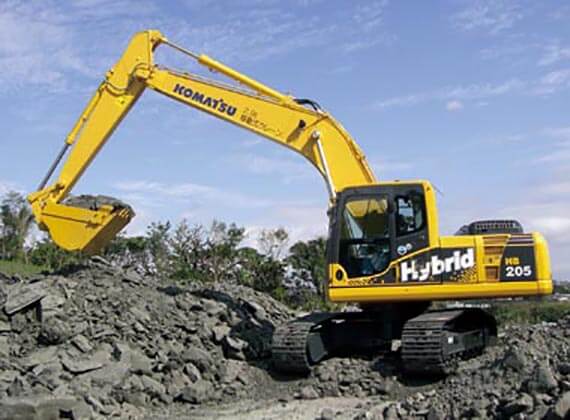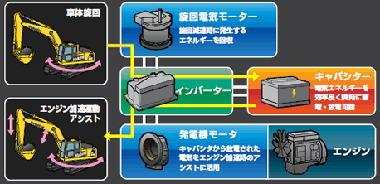2010
As use of ICT for construction equipment became more common, things like crewless dump trucks, IT execution, and KOMTRAX were further developed. Hybrid equipment that decreased both fuel consumption and carbon dioxide emission was introduced and marked a new generation of construction machines.


Komatsu started distributing the new hybrid Hydraulic excavator, HB205 and HB215LC to the global market. After Japan, it extended the sales to North America, China, Central/South America, South East Asia, and Europe.
This was a full model change for the hybrid Hydraulic excavator. It reduced fuel consumption and NOX/CO2 emission, and it made inspection and maintenance easier by renewing the hybrid component. Optional device such as the arm crane (*1) and attachable shared pipe made it possible for this model to work at a wider range of construction sites.
With Komatsu's original hybrid system, it converts the energy that is generated when the machinery is slowing down into electric power via a circulating electric motor, reserved it in a capacitor, and uses it as additional energy when the engine accelerates via an electric power motor, which results in significant fuel consumption reduction. All hybrid components including the electric power motor, circulating electric motor, inverter, and capacitor were developed and produced by Komatsu.(*2) This compact model is reliable, durable, and equipped with KOMTRAX.
*1: Arm crane option is only available in Japan.
*2: Except capacitor cell.
Weight: 19,800kg, Bucket capacity: 0.8m3(HB2051)
Hydraulic excavator
Since its first emergence in 1951, it took only 50 years for the hydraulic shovel to establish its primary position on construction sites worldwide. Its size ranges from mini to super size depending on the scale of construction, and during the half century, it kept evolving by achieving a minimum rear-swing radius and adapting styles that would work with characteristics of each site. Mirroring the movement of a human hand, a hydraulic shovel will continue to evolve during the 21st century.